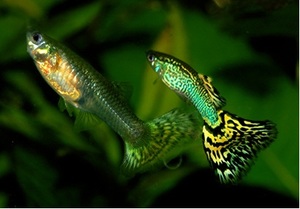When it comes to breeding fish, guppies are likely the easiest live-bearing fish to successfully breed. Not only are guppies easy to breed, but there are countless types of guppies available in nearly every color of the rainbow. Breeding guppies takes a little bit of knowledge, but with some reading and a little bit of patience, breeding guppies is easy.
Selective breeding
If you want to have more control over how your guppies breed, you will need to have two separate tanks or a divider down the center of your tank to keep males away from females. You will then be able to select the female and the male that you would like to breed and place them together in a separate breeding tank. Some breeders only leave the fish together for a few hours, while others will leave them together for a few weeks until just prior to when the female is expected to give birth.
Community breeding
Community breeding is sometimes preferable because there is no need for a separate breeding tank. With community breeding, however, you have less control over how the offspring will look as the males and females all live in the tank together and breed with each other of their own accord. This can be especially fun because the appearance of the offspring are more of a surprise when the breeding is not controlled. In a community tank, however, it may be more difficult to determine when a female is due to give birth as you may not know when she bred.
Placing the mother in a hatchery
Guppies typically gestate for 28 days, however, some guppies gestate as briefly as 21 days or as long as 40 days. It is important to pay attention to your female guppies and watch for signs of impending birth. Female guppies will become box like in appearance from the front as their stomach swells, and a dark spot known as the gestational spot on her abdomen will become even darker just prior to giving birth. The mother will need to be placed in a special hatchery set up before giving birth in order to prevent her from from eating the fry once they are born. Some breeders choose not to use a hatchery, however, not using a hatchery can greatly reduce the number of fry that survive as the males and females in the community tank will eat any of the fry that they can get to. Once the fry have been born, you may return the mother to the community tank, but be aware that she may continue to have babies even after she appears to be done.
Caring for young fry
Young fry need to be fed often, sometimes as many as six times per day. It is important to feed fry as soon as possible after birth. It is important to feed the fry often as failing to due so could result in death. As the fry grow older, they can survive being fed less often. Once the fry are 1-2 months old, they should be large enough to be placed in the community tanks with the other adult guppies. Do not place the fry in the community tank if they are too small as the other guppies may try to eat them.




